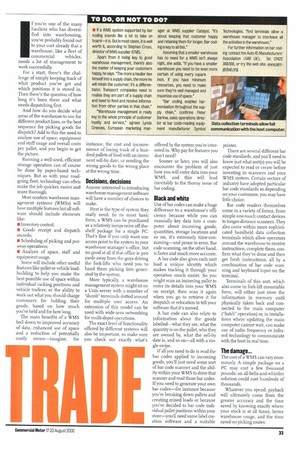f you're one of the many hauliers who has diversified
Page 35

If you've noticed an error in this article please click here to report it so we can fix it.
into warehousing, you've probably found out to your cost already that a warehouse, like a fleet of commercial vehicles, needs a lot of management to work successfully.
For a start, there's the challenge of simply keeping track of what product you've got and which positions it is stored in. Then there's the question of how long it's been there and what needs dispatching first.
And how do you decide what areas of the warehouse to use for different product lines, or the best sequence for picking goods for dispatch? Add to this the need to analyse use of space, equipment and staff usage and overall costs per pallet, and you begin to get the picture.
Running a well-used, efficient storage operation can of course be done by paper-based techniques. But as with your roadgoing fleet, technology can often make the job quicker, easier and more thorough.
Most modern warehouse management systems (WMSs) will have multiple features but all software should include elements like: • Inventory control; • Goods receipt and dispatch records; • Scheduling of picking and putaway operations; • Analysis of space, staff and equipment usage.
Some will include other useful features like pallet or vehicle loadbuilding to help you make the best possible use of space within individual racking positions and vehicle trailers; or the ability to work out what you should charge customers for holding their goods, based on how much you've held and for how long.
The main benefits of a WMS boil down to improved accuracy of data, enhanced use of space and a reduction of potentially costly errors—imagine, for instance, the cost and inconvenience of losing track of a hundred pallets of food with an imminent sell-by date, or sending the wrong goods to the wrong place at the wrong time.
Decisions, decisions
Anyone interested in introducing warehouse management software will have a number of choices to make.
First is the type of system they really need. In its most basic form, a WMS can be purchased as a relatively inexpensive off-theshelf package for a single PC. That's fine if you only want one access point to the system in your warehouse manager's office, but no good at all if that office is 300 yards away from the guys driving the fork-lifts who need you to hand them picking lists generated by the system.
More typically, a warehouse management system might sit on a Unix server with a number of "dumb" terminals dotted around for multiple user access. An extension of this model can be used with wide-area networking for multi-depot operations.
The exact level of functionality offered by different systems will also be important, so make sure you check out exactly what's offered by the system you're interested in. Why pay for features you don't need?
Sooner or later, you will also encounter the problem of just how you will enter data into your WMS, and this will lead inevitably to the thorny issue of bar coding.
Black and white Use of bar codes can make a huge difference to a warehouse's efficiency because while you can manually key data into a computer about incoming goods, quantities, storage locations and so on, it's extremely time-consuming—and prone to error. Bar code scanning, on the other hand, is faster and much more accurate.
A bar code also gives each unit load a unique identity which makes tracking it through your operation much easier. So you might scan an incoming pallet to enter its details into your WMS on receipt, then scan it again when you go to retrieve it for despatch or relocation to tell your software that it's moved.
A bar code can also relate to information about the goods labelled—what they are, what the quantity is on the pallet, who they are owned by, what the sell-by date is, and so on—all with a single swipe.
If all you need to do is read the bar codes applied to incoming goods, you'll just need some sort of bar code scanner and the ability within your WMS to drive that scanner and read those bar codes. If you need to generate your own bar codes—for instance because you're breaking down pallets and creating mixed loads or because you've decided to bar code individual pallet positions within your store—you'll need some label creation software and a suitable printer.
There are several different bar code standards, and you'll need to know just what sort(s) you will be expected to read or create before investing in scanners and your WMS system. Certain sectors of industry have adopted particular bar code standards so depending on your customers, you may have little choice.
Bar code readers themselves come in a variety of forms, from simple one-touch contact devices to longer-distance scanners. They also come within more sophisticated handheld data collection terminals which allow operators around the warehouse to receive instructions, complete them, confirm what they've done and then get fresh instructions, all by a combination of bar code scanning and keyboard input on the terminal.
Terminals of this sort, which also come in fork-lift mountable form, will either just store the information in memory until physically taken back and connected to the main computer ("batch" operation) or, in installations where updating the main computer cannot wait, can make use of radio frequency or infrared technology to communicate with the host in real time.
The damage...
The cost of a WMS can vary enormously. A simple package on a PC may cost a few thousand pounds; an all-bells-and-whistles solution could cost hundreds of thousands,
Whatever you spend, payback will ultimately come from the greater accuracy and the time saved by knowing exactly where your stock is at all times, better warehouse usage, and the time saved on picking routes.




































































































